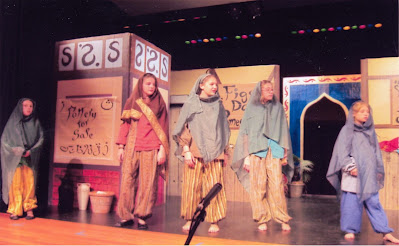Size Matters
“All the world’s a stage." True enough, but some stages are too small and some stages are too large. A lot of youth theatre groups use the local high school stage, which in many cases is extremely wide and far from the audience. Sometimes a theatre group is confined to an elementary school stage, which is often too small for a full cast musical.
If you are lucky enough to have built the perfect size stage for your group, then you have probably built a mid-size stage large enough for a big musical production but small enough to not dwarf your young actors, and close enough to your audience so they can both hear the kids and see them close up. If you have the opportunity to choose from the various school stages in your town, you would do well to choose a stage that meets those criteria.
However, there are ways to get around stage size problems: For an oversized high school stage, it is fairly easy to construct a faux proscenium with 4x8 insulation board, thereby bringing the stage down to a manageable size. Or you can place your flats and set on only the front portion of the stage in front of the main curtain. That way the actors are closer to the audience and more easily heard. If your stage is too small, consider using the audience area as part of your production — actors can enter, exit, even perform certain scenes in front of the stage or even in the aisles. If you are performing for children, they will greatly enjoy the intimacy of having the actors right there next to them. Risers leading up to the stage are helpful in adding space and movement to and from the stage.
Backdrops
Rented Drops are not too expensive, but most are the size of a large high school stage. It is possible to roll the drop on the sides and/or bottom, and some rented drops have extra fittings for lowering the top.
DIY Drops are possible if you have an artist on your set crew. Buy inexpensive canvas cloth and sew it together to fit the size of your stage. You will need the hardware required to insert grommets along the top for hanging and either chain or PVC pipe to hold down the bottom.
Projected Digital Backdrops are the latest thing, but very expensive. If you are an established or well-funded group, it may be worth it to purchase a projector and professional screen. There are numerous digital projectable drops that can be rented. The projection is done from the back of the screen to avoid shadows.
Three-Dimensional Sets and Flats
When we began our group thirty years ago, we used canvas flats and plywood. Then we discovered light, cheap foam insulation board. Best for flats is the 1 1/2-inch isoboard sold for roofing insulation, which comes in 4x8-foot pieces. It can be painted on both sides and can be turned to create two different scenes. You must paint it with a primer, such as Kilz, before painting on your scene. The pieces can be held together by canvas strips glued along the edges to create an accordion type connection when folded for storage.
Regular foam insulation board, sold in various widths, can be used to create set pieces such as fireplaces, a jukebox, a book case, etc. that, when attached with wooden BBQ skewers, hold up the flats. Sometimes you need a sandbag or two to help support the structure.
To give your sets or props texture and depth, you can carve into the foam board. It is possible to carefully melt the foam board with a plumber’s torch before painting to create a brick or stone look. You can then glue the melted foam board on to the isoboard flat. NOTE: The fumes from melting foam board are VERY toxic. Only do this outdoors and with a good mask.
 |
| We re-decorated the isoboard set from “Pied Piper” (top) and added a palace door for “Aladdin" (bottom). |
